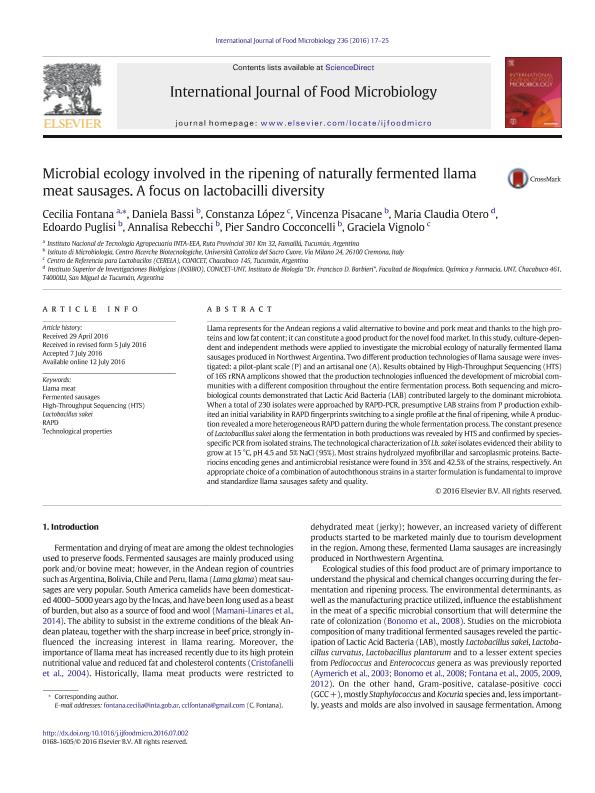Artículo
Microbial ecology involved in the ripening of naturally fermented llama meat sausages. A focus on lactobacilli diversity.
Fontana, Cecilia Alejandra ; Bassi, Daniel; López, Constanza María
; Bassi, Daniel; López, Constanza María ; Pisacane, Vicenza; Otero, María Claudia
; Pisacane, Vicenza; Otero, María Claudia ; Puglisi, Edoardo; Rebecchi, Annalisa; Cocconcelli, Pier; Vignolo, Graciela Margarita
; Puglisi, Edoardo; Rebecchi, Annalisa; Cocconcelli, Pier; Vignolo, Graciela Margarita
 ; Bassi, Daniel; López, Constanza María
; Bassi, Daniel; López, Constanza María ; Pisacane, Vicenza; Otero, María Claudia
; Pisacane, Vicenza; Otero, María Claudia ; Puglisi, Edoardo; Rebecchi, Annalisa; Cocconcelli, Pier; Vignolo, Graciela Margarita
; Puglisi, Edoardo; Rebecchi, Annalisa; Cocconcelli, Pier; Vignolo, Graciela Margarita
Fecha de publicación:
12/07/2016
Editorial:
Elsevier Science
Revista:
International Journal of Food Microbiology
ISSN:
0168-1605
e-ISSN:
1879-3460
Idioma:
Inglés
Tipo de recurso:
Artículo publicado
Resumen
Llama represents for the Andean regions a valid alternative to bovine and pork meat and thanks to the high proteins and low fat content; it can constitute a good product for the novel food market. In this study, culture-dependent and independent methods were applied to investigate the microbial ecology of naturally fermented llama
sausages produced in Northwest Argentina. Two different production technologies of llama sausage were investigated: a pilot-plant scale (P) and an artisanal one (A). Results obtained by High-Throughput Sequencing (HTS) of 16S rRNA amplicons showed that the production technologies influenced the development of microbial communities with a different composition throughout the entire fermentation process. Both sequencing and microbiological counts demonstrated that Lactic Acid Bacteria (LAB) contributed largely to the dominant microbiota.
When a total of 230 isolates were approached by RAPD-PCR, presumptive LAB strains from P production exhibited an initial variability in RAPD fingerprints switching to a single profile at the final of ripening, while A production revealed a more heterogeneous RAPD pattern during the whole fermentation process. The constant presence of Lactobacillus sakei along the fermentation in both productions was revealed by HTS and confirmed by speciesspecific PCR from isolated strains. The technological characterization of Lb. sakei isolates evidenced their ability to
grow at 15 °C, pH 4.5 and 5% NaCl (95%). Most strains hydrolyzed myofibrillar and sarcoplasmic proteins. Bacteriocins encoding genes and antimicrobial resistance were found in 35% and 42.5% of the strains, respectively. An appropriate choice of a combination of autochthonous strains in a starter formulation is fundamental to improve and standardize llama sausages safety and quality.
Archivos asociados
Licencia
Identificadores
Colecciones
Articulos(CERELA)
Articulos de CENTRO DE REFERENCIA PARA LACTOBACILOS (I)
Articulos de CENTRO DE REFERENCIA PARA LACTOBACILOS (I)
Citación
Fontana, Cecilia Alejandra; Bassi, Daniel; López, Constanza María; Pisacane, Vicenza; Otero, María Claudia; et al.; Microbial ecology involved in the ripening of naturally fermented llama meat sausages. A focus on lactobacilli diversity.; Elsevier Science; International Journal of Food Microbiology; 236; 12-7-2016; 17-25
Compartir
Altmétricas



